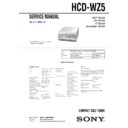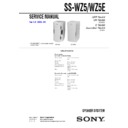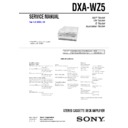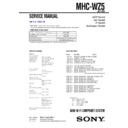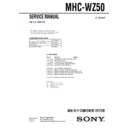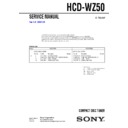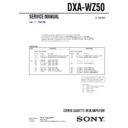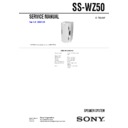Sony HCD-WZ5 / HCD-WZ50 / MHC-WZ5 Service Manual ▷ View online
HCD-WZ5
AEP Model
UK Model
E Model
Australian Model
SERVICE MANUAL
COMPACT DISC TUNER
SPECIFICATIONS
Ver 1.1 2003. 11
• HCD-WZ5 is the tuner, and CD
section in MHC-WZ5.
CD player section
System
Compact disc and digital
audio system
audio system
Laser
Semiconductor laser
(
(
λ=780 nm)
Emission duration:
continuous
continuous
Frequency response
2 Hz – 20 kHz (
±0.5 dB)
Wavelength
780 – 790 nm
Signal-to-noise ratio
More than 90 dB
Dynamic range
More than 90 dB
OPTICAL CD DIGITAL OUT (European and
Australian models only)
(Square optical connector jack, rear panel)
Wavelength
Australian models only)
(Square optical connector jack, rear panel)
Wavelength
660 nm
Tuner section
FM stereo, FM/AM superheterodyne tuner
FM tuner section
Tuning range
87.5 – 108.0 MHz
antenna
FM lead antenna
antenna terminals
75 ohms unbalanced
Intermediate frequency
10.7 MHz
AM tuner section
Tuning range
European model:
European model:
531 – 1,602 kHz
(with the tuning interval
set at 9 kHz)
(with the tuning interval
set at 9 kHz)
Latin American model:
Other model:
General
Power requirements
Power consumption
European model:
European model:
150 watts
0.3 watts (at the Power
Saving Mode)
0.3 watts (at the Power
Saving Mode)
Except for European model:
180 watts
Dimensions (w/h/d)
CD player/Tuner:
CD player/Tuner:
Approx. 255
× 135 ×
355 mm
Mass
CD player/Tuner:
CD player/Tuner:
Approx. 2.8 kg
Design and specifications are subject to change
without notice.
without notice.
Power voltage is D 9V and fed with STEREO
CASSETTE DECK AMPLIFIER (DXA-WZ5)
from the external SYSTEM CONTROL connectors.
CASSETTE DECK AMPLIFIER (DXA-WZ5)
from the external SYSTEM CONTROL connectors.
530 – 1,710 kHz
(with the tuning interval
set at 10 kHz)
531 – 1,710 kHz
(with the tuning interval
set at 9 kHz)
530 – 1,710 kHz
(with the tuning interval
set at 10 kHz)
531 – 1,602 kHz
(with the tuning interval
set at 9 kHz)
(with the tuning interval
set at 10 kHz)
531 – 1,710 kHz
(with the tuning interval
set at 9 kHz)
530 – 1,710 kHz
(with the tuning interval
set at 10 kHz)
531 – 1,602 kHz
(with the tuning interval
set at 9 kHz)
antenna
AM loop antenna
antenna terminals
External antenna terminal
Intermediate frequency
450 kHz
Sony Corporation
Home Audio Company
Published by Sony Engineering Corporation
9-877-331-02
2003K16-1
© 2003.11
Model Name Using Similar Mechanism
NEW
CD
CD Mechanism Type
CDM77B-K6BD47S
Section
Base Unit Name
BU-K6BD47S
Optical Pick-up Name
KSM-213D
2
HCD-WZ5
Laser component in this product is capable
of emitting radiation exceeding the limit for
Class 1.
of emitting radiation exceeding the limit for
Class 1.
CAUTION
Use of controls or adjustments or performance of procedures
other than those specified herein may result in hazardous radiation
exposure.
other than those specified herein may result in hazardous radiation
exposure.
Notes on chip component replacement
• Never reuse a disconnected chip component.
• Notice that the minus side of a tantalum capacitor may be
• Notice that the minus side of a tantalum capacitor may be
damaged by heat.
Flexible Circuit Board Repairing
• Keep the temperature of soldering iron around 270˚C
during repairing.
• Do not touch the soldering iron on the same conductor of the
circuit board (within 3 times).
• Be careful not to apply force on the conductor when soldering
or unsoldering.
TABLE OF CONTENTS
1. GENERAL
·········································································· 4
2. DISASSEMBLY
2-1. Case ··············································································· 7
2-2. Front Panel Assy ··························································· 8
2-3. PANEL Board, CD-TC-SW Board, ENTER-SW
2-2. Front Panel Assy ··························································· 8
2-3. PANEL Board, CD-TC-SW Board, ENTER-SW
Board, BACK-LIGHT Board, LCD Board ··················· 8
2-4. Tuner (FM/AM), WOOFER Board ······························ 9
2-5. MAIN Board, REGULATOR Board, HP-AMP Board ··· 9
2-6. CD mechanism deck (CDM77B-K6BD47S) ·············· 10
2-7. Tray (AU) ···································································· 10
2-8. MS-128 Board ···························································· 11
2-9. Base Unit (BU-K6BD47S) ········································· 11
2-10. CD Board, Optical Pick-Up Block (KSM-213D) ······· 12
2-5. MAIN Board, REGULATOR Board, HP-AMP Board ··· 9
2-6. CD mechanism deck (CDM77B-K6BD47S) ·············· 10
2-7. Tray (AU) ···································································· 10
2-8. MS-128 Board ···························································· 11
2-9. Base Unit (BU-K6BD47S) ········································· 11
2-10. CD Board, Optical Pick-Up Block (KSM-213D) ······· 12
3. ELECTRICAL ADJUSTMENTS
······························· 13
4. TEST MODE
···································································· 14
5. DIAGRAMS
5-1. Circuit Boards Location ·············································· 15
5-2. Block Diagrams - Main Section - ······························· 16
5-3. Printed Wiring Board - CD Board - ···························· 17
5-4. Schematic Diagram - CD Board - ······························· 18
5-5. Printed Wiring Board - MAIN Section- ······················ 19
5-6. Schematic Diagram
5-2. Block Diagrams - Main Section - ······························· 16
5-3. Printed Wiring Board - CD Board - ···························· 17
5-4. Schematic Diagram - CD Board - ······························· 18
5-5. Printed Wiring Board - MAIN Section- ······················ 19
5-6. Schematic Diagram
- MAIN Section (1/2) - ··········· 20
- MAIN Section (2/2) - ··········· 21
- MAIN Section (2/2) - ··········· 21
5-7. Printed Wiring Board - PANEL Board - ····················· 22
5-8. Schematic Diagram - PANEL Board - ························ 23
5-9. Printed Wiring Board - LCD/SWITCH Section - ······· 24
5-10. Schematic Diagram - LCD/SWITCH Section - ·········· 25
5-11. Printed Wiring Board - REGULATOR Board - ·········· 26
5-12. Schematic Diagram - REGULATOR Board - ············ 27
5-13. IC Block Diagrams ····················································· 28
5-14. IC Pin Function Description ······································· 29
5-8. Schematic Diagram - PANEL Board - ························ 23
5-9. Printed Wiring Board - LCD/SWITCH Section - ······· 24
5-10. Schematic Diagram - LCD/SWITCH Section - ·········· 25
5-11. Printed Wiring Board - REGULATOR Board - ·········· 26
5-12. Schematic Diagram - REGULATOR Board - ············ 27
5-13. IC Block Diagrams ····················································· 28
5-14. IC Pin Function Description ······································· 29
6. EXPLODED VIEWS
6-1. Front Panel Section ····················································· 31
6-2. Chassis Section ···························································· 32
6-3. CD Mechanism Deck Section ····································· 33
6-4. Optical Pick-up Section (KSM-213D) ························ 34
6-2. Chassis Section ···························································· 32
6-3. CD Mechanism Deck Section ····································· 33
6-4. Optical Pick-up Section (KSM-213D) ························ 34
7. ELECTRICAL PARTS LIST
······································· 35
The laser diode in the optical pick-up block may suffer electrostatic
break-down because of the potential difference generated by the
charged electrostatic load, etc. on clothing and the human body.
During repair, pay attention to electrostatic break-down and also
use the procedure in the printed matter which is included in the
repair parts.
The flexible board is easily damaged and should be handled with
care.
break-down because of the potential difference generated by the
charged electrostatic load, etc. on clothing and the human body.
During repair, pay attention to electrostatic break-down and also
use the procedure in the printed matter which is included in the
repair parts.
The flexible board is easily damaged and should be handled with
care.
NOTES ON LASER DIODE EMISSION CHECK
The laser beam on this model is concentrated so as to be focused on
the disc reflective surface by the objective lens in the optical pick-
up block. Therefore, when checking the laser diode emission,
observe from more than 30 cm away from the objective lens.
the disc reflective surface by the objective lens in the optical pick-
up block. Therefore, when checking the laser diode emission,
observe from more than 30 cm away from the objective lens.
NOTES ON HANDLING THE OPTICAL PICK-UP
BLOCK OR BASE UNIT
BLOCK OR BASE UNIT
This appliance is
classified as a CLASS 1
LASER product. This
label is located on the
rear exterior.
classified as a CLASS 1
LASER product. This
label is located on the
rear exterior.
The following caution label is located inside the apparatus.
Ver 1.1 2003.11
3
HCD-WZ5
SAFETY-RELATED COMPONENT WARNING!!
COMPONENTS IDENTIFIED BY MARK
0
OR DOTTED LINE WITH
MARK
0
ON THE SCHEMATIC DIAGRAMS AND IN THE PARTS
LIST ARE CRITICAL TO SAFE OPERATION. REPLACE THESE
COMPONENTS WITH SONY PARTS WHOSE PART NUMBERS
APPEAR AS SHOWN IN THIS MANUAL OR IN SUPPLEMENTS
PUBLISHED BY SONY.
COMPONENTS WITH SONY PARTS WHOSE PART NUMBERS
APPEAR AS SHOWN IN THIS MANUAL OR IN SUPPLEMENTS
PUBLISHED BY SONY.
MODEL IDENTIFICATION
— BACK PANEL —
• Abbreviation
AUS
: Australian model
E2
: 120V AC Area in E model
E3
: 240V AC Area in E model
KR
: Korean model
TW
: Taiwan model
PARTS No.
Unleaded solder
Boards requiring use of unleaded solder are printed with the lead-
free mark (LF) indicating the solder contains no lead.
(Caution: Some printed circuit boards may not come printed with
the lead free mark due to their particular size.)
free mark (LF) indicating the solder contains no lead.
(Caution: Some printed circuit boards may not come printed with
the lead free mark due to their particular size.)
: LEAD FREE MARK
Unleaded solder has the following characteristics.
• Unleaded solder melts at a temperature about 40
• Unleaded solder melts at a temperature about 40
°C higher than
ordinary solder.
Ordinary soldering irons can be used but the iron tip has to be
applied to the solder joint for a slightly longer time.
Soldering irons using a temperature regulator should be set to
about 350
Ordinary soldering irons can be used but the iron tip has to be
applied to the solder joint for a slightly longer time.
Soldering irons using a temperature regulator should be set to
about 350
°C.
Caution: The printed pattern (copper foil) may peel away if the
heated tip is applied for too long, so be careful!
heated tip is applied for too long, so be careful!
• Strong viscosity
Unleaded solder is more viscous (sticky, less prone to flow) than
ordinary solder so use caution not to let solder bridges occur such
as on IC pins, etc.
ordinary solder so use caution not to let solder bridges occur such
as on IC pins, etc.
• Usable with ordinary solder
It is best to use only unleaded solder but unleaded solder may
also be added to ordinary solder.
also be added to ordinary solder.
[When bringing in the equipment for service]
In case of repairing, please bring the entire system set([HCD-WZ5,
DXA-WZ5],except for the speaker) to the service station.
DXA-WZ5],except for the speaker) to the service station.
MODEL
AEP, UK models
E2, E3 models
AUS model
KR, TW models
PARTS No.
4-244-440-0
s
4-244-440-1
s
4-244-440-2
s
4-244-440-7
s
4
HCD-WZ5
This section is extracted
from instruction manual.
from instruction manual.
SECTION 1
GENERAL
Main unit
CD 5 (9, 10, 17, 18)
CD SYNC 9 (17)
Control lever 7 (7, 20)
DIMMER w; ( 24)
Disc tray ws
DISPLAY ql (15, 23, 24)
Display window wa
EQ EDIT qk (20, 29)
GROOVE 7 (19)
Headphone jack qs
CD SYNC 9 (17)
Control lever 7 (7, 20)
DIMMER w; ( 24)
Disc tray ws
DISPLAY ql (15, 23, 24)
Display window wa
EQ EDIT qk (20, 29)
GROOVE 7 (19)
Headphone jack qs
MD (VIDEO) 2 (26)
MOVIE MODE 7 (19)
MUSIC MODE 7 (19, 20)
PLAY MODE/DIRECTION qg
MOVIE MODE 7 (19)
MUSIC MODE 7 (19, 20)
PLAY MODE/DIRECTION qg
(9, 10, 16, 17, 18, 30)
PUSH ENTER 7 (8, 10, 12, 20,
21, 22)
Remote sensor qd
REPEAT/FM MODE qh (10, 14)
SURROUND 7 (20)
TAPE A/B 3 (16, 17, 18)
TUNER MEMORY qf (12)
TUNER/BAND 6 (12, 13, 18)
TUNING MODE qj (12, 13)
VOLUME qa (21)
REPEAT/FM MODE qh (10, 14)
SURROUND 7 (20)
TAPE A/B 3 (16, 17, 18)
TUNER MEMORY qf (12)
TUNER/BAND 6 (12, 13, 18)
TUNING MODE qj (12, 13)
VOLUME qa (21)
?/1 (power) 1 (7, 13, 21, 29)
X (pause) 4 (9, 16)
nN (play) 4 (9, 16, 17)
x (stop) 4 (7, 9, 13, 16, 17, 29)
+M> (fast forward/go
X (pause) 4 (9, 16)
nN (play) 4 (9, 16, 17)
x (stop) 4 (7, 9, 13, 16, 17, 29)
+M> (fast forward/go
forward) 4 (8, 9, 12, 16, 21,
30)
30)
.m– (rewind/go back) 4
(8, 9, 12, 16, 21)
Z (open/close) 8 (8)
z START q; (17, 18)
z START q; (17, 18)
ALPHABETICAL ORDER
A – L
M – Z
BUTTON DESCRIPTIONS
CD player/Tuner

